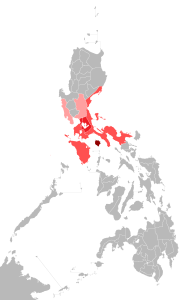By Sarah-Claire Jordan
 For those of you who don’t know what Tagalog is, it is a language commonly spoken in the Philippines. A standardized variety of it, Filipino, is the official language of the country, along with English. About a quarter of Filipinos speak Tagalog as their native language, and most of the population speaks it as a second language. It is an Austronesian language, like Indonesian, Malagasy, and Hawaiian.
For those of you who don’t know what Tagalog is, it is a language commonly spoken in the Philippines. A standardized variety of it, Filipino, is the official language of the country, along with English. About a quarter of Filipinos speak Tagalog as their native language, and most of the population speaks it as a second language. It is an Austronesian language, like Indonesian, Malagasy, and Hawaiian.
Tagalog is native to the main island of Luzon, specifically the south and central regions of it. The standardized variety, known as Filipino, is based on the Tagalog spoken in Manila, the capital of the Philippines. It wasn’t designated as an official language along with English until 1973. Though Tagalog was declared the official language of the land in the first constitution in 1897, but soon afterwards Spanish and English replaced it. Here are four other bits of information to know about Tagalog:
- People have written in Tagalog for centuries
The first written record of Tagalog dates as far back as 900 CE. It was a copperplate inscription that included some Javanese, Sanskrit, and more. After that, the first complete book to be written in Tagalog was a religious text, called Doctrina Cristiana, or Christian Doctrine. It was printed in 1593, and was followed by many texts about Tagalog grammar and vocabulary written by members of the Spanish church while the Philippines was occupied by Spain. Since then, the majority of Tagalog literature has been religious in nature.
- Dialects of Tagalog are hard to classify
Tagalog is often considered a language with more than one standard form, though Filipino, based on the Manila dialect, is considered the official standard form of Tagalog. Some linguists have identified eight different dialects of Tagalog, but others proposed grouping them all into four main categories. Those categories are: Northern, Central, Southern, and Marinduque. Northern Tagalog dialects include the Bulacan dialect as a prime example, while Central Tagalog includes the dialect spoken in Manila. Batangas is the dialect the most represents the Southern dialects, and Marinduque, which is the closest to the Tagalog spoken before Spain colonized the Philippines.
- Tagalog speakers code-switch often
Since there are two official languages in the Philippines, along with many regional languages, it isn’t uncommon to hear Filipinos switch between English and Tagalog in the same sentence. Some people only use a few English words and speak for the most part in Tagalog, but code-switching is so prevalent that there are even names for it: Taglish and Englog. People who live in the city, are highly educated, and who were born after World War II are the most likely candidates for code-switching.
- Spanish has had a great influence on Tagalog
Thanks to colonization, Spanish has had probably the strongest influence on Tagalog than any other language. Almost half of the vocabulary of Tagalog consists of Spanish loanwords, and certain types of vocabulary, like months and days of the week, are just slightly modified versions of the original Spanish words.
Tagalog is an important language to know about, as there are about 3 million people living in the U.S. of Filipino descent. Alpha Omega Translations offers translation, interpretation, and desktop publishing services that have the potential to improve the lives of Filipino immigrants with low levels of English.
For an overview of our translation expertise, visit our medical and life science translation page.



